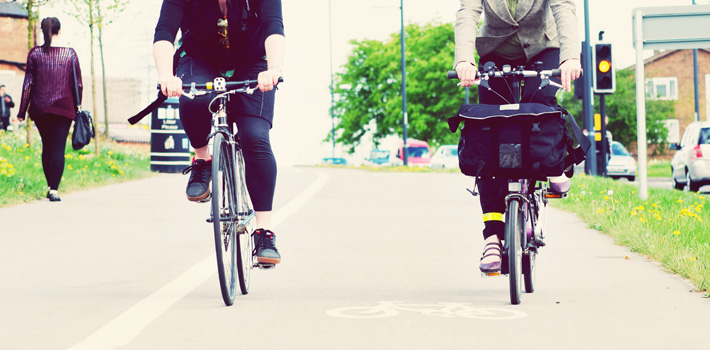If you’re cycling to work regularly, there are just a few things that we think you should know.
We’ve tried to answer the basics in this section, so if you’re thinking about commuting by bike, have a read through these pages first because they might just give you that golden nugget of information that makes your ride that bit easier!
The Bike
Your ride to work will be much easier with the right type of bike. A mountain bike with full suspension will wear you out on a 5 mile road ride and a road bike will probably shake your spine to pieces if you try and cycle down a gravel path. Make sure you get it right:
Road bikes with skinny wheels and dropped handlebars are perfect for smooth road riding and will make a ride like this a breeze.
A mountain bike with suspension and fat knobbly tyres will help you to fly down a gravel or dirt track but the extra resistance from those big tyres will waste lots of energy on the road.
A hybrid will suit riders whose trip is mostly on the road but occasionally ventures on rougher surfaces.
If you want to know more, see our guide to different types of bike.
The Route
The key here is to stop thinking like a car driver. In a car you generally plan the shortest route with the quickest road speeds. For a pleasant cycle you want fewer hills, dedicated cycle lanes and quiet roads without fast moving traffic. Choosing the right route for your cycle to work is the one thing that can make the difference between enjoying your commute and setting off each morning with apprehension. On a bike, the quickest route isn’t always the best!
There might be a route that is slightly longer but avoids that huge hill that you dread. Is there a cycle path that you just don’t know about that will help you to avoid the roads?
Our advice is to give each route a try once.
Only when you’ve tried every possible way will you know which you prefer.
Carrying your stuff
If you are cycling to work you will probably have things that you need carry. From your work clothes to files or a laptop, you want your stuff to get to work dry, clean and in full working order. When getting a bag to carry stuff, you might instinctively just go out and buy a rucksack.
Having a heavy rucksack strapped to your back on a bike will raise your centre of gravity up higher, making you more unstable. A backpack is also likely to make you hotter and give you a sweaty back (which is never a good thing). Investing in some good panniers from the start will make your whole ride more enjoyable. It’s worth pointing out that if you have a pannier on just one side of the bike, it can totally throw you off your balance, so try and get one for each side and put equal amounts in each. A lot of double sided panniers come off the bike as one, easy to carry bag.
Whatever you choose to carry your stuff, the most important thing is that its water proof and weather resistant. Remember that we live in Britain, and just because it’s sunny when you set off, doesn’t mean it will be sunny when you arrive.
Safety First
Lots of budding bicycle commuters never get give it a go because of fears for their safety. Cycling is great fun and should be enjoyed. It isn’t inherently dangerous as long as you follow some basic common-sense safety rules. Remember that you are not indestructible and getting there in one piece is the most important thing.
Do…
- …wear as much high visibility clothing as you can get. You can never have too much!
- …wear a helmet. It’s not a legal requirement but your head is quite important, so protect it.
- …use lights in any low light situations, including rain and fog.
- …try and complete as much of your journey on dedicated cycle paths as possible.
- …keep to quieter roads. Cycling down the A38 is never a good idea!
- …obey the Highway Code. Stop at red traffic lights and don’t ride erratically.
- …ride a few feet away from the curb. Too close and cars might try and squeeze past when it’s not safe.
- …keep your wits about you at all times.
Don’t…
- assume people have seen you, ride past junctions slowly.
- try and beat world speed records. Car drivers won’t expect a cyclist to be doing 35mph!
- ever leave your comfort zone. It’s not worth it to save 30 seconds off your journey.
What tools do I need to take with me?
Be prepared! You wouldn’t go out in your car without a spare wheel, jack and a wheel spanner, so why would you go out on a bike with no tools to fix a puncture?
As a bare minimum you should carry:
Spare Inner Tube
They don’t cost much and simply replacing the inner tube is much easier than trying to repair a puncture at the side of the road. You can repair the puncture when you get home!
Hand Pump with a Pressure Gauge
You will need to be able to pump that tyre back up and a pressure gauge will allow you to know when you can stop pumping and start pedalling again.
2 Tyre Levers
These tools will make it really easy to get your tyre off your wheel and help you to get it back on again.
Spanners and Allen Keys
Different bikes need different tools so make sure you have the right tools to remove the wheels and adjust parts like the seat, handlebars and brakes.
